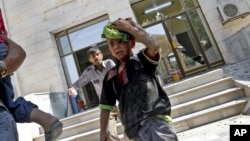As Syrian rebels look to the skies, they see a battlefield out of their reach.
In fighting Syrian government forces of Bashar al-Assad for 18 months, the insurgents are essentially armed with light weapons. They face a well-equipped military, whose Soviet and Russian-made arsenal includes warplanes, helicopters, tanks, heavy artillery and armored personnel carriers.
It is because of this disparity in weaponry that rebel forces have been calling for the establishment of a no-fly zone over Syria, ostensibly to protect the civilians who have been under intense attack by Mr. Assad’s military.
But their calls receive little international support.
Tough parameters
Retired U.S. Air Force Lieutenant General David Deptula, who flew more than 80 combat missions in the late 1990s enforcing a no-fly zone over northern Iraq, said first of all, it is essential to define the parameters of a no-fly zone before establishing one.
“The questions of why we are doing this and what is the desired outcome - those are issues and questions that need to be answered first,” he said. “People tend to immediately go into ‘Well, how do you do this’?
"But before you answer the question ‘how,’ one needs to answer the question ‘why’?" he said. "And only when all the parties to doing this are comfortable with the answers to those questions, does one proceed. You have to define the purpose before you define the action.”
Sean O’Connor, a military expert who writes for the British publication Jane’s, said the purpose of the no-fly zones over Iraq - from 1991 to 2003 - was clear.
“The two no-fly zones in northern Iraq and southern Iraq were basically designed to provide safe havens for the civilian populations where [Iraqi leader] Saddam [Hussein] couldn’t fly his air force," O’Connor said.
Saddam “was still permitted to operate in central Iraq, in and around Baghdad and those areas - but he was technically not permitted to fly around northern Iraq, around Mosul, or down in southern Iraq, around Basra," he said. "And that pretty much restricted their operations.”
Libya model
Last year, a U.N. Security Council resolution established a no-fly zone over Libya to protect civilians from attacks by the forces of Libyan leader Colonel Moammar Gadhafi. But the resolution also authorized member states to “take all necessary measures” to ensure the ban on flights.
Ward Carroll, who patrolled the Iraqi no-fly zones, and flew over Bosnia in 1995, said the purpose of the Libyan mission changed.
“At first we said it is all about protecting civilians and that was the impetus behind the NATO mission,” Carrol said. “But we saw what happened - ultimately, it was regime change.”
Retired Lt. Gen. Deptula said that in the Libyan campaign - which lasted seven months - NATO aircraft became the rebels’ air force.
“Because by virtue of their air operations over Libya, those operations reduced the Libyan military to dismounted infantry where this ragtag group of rebels could then attack and defeat Gadhafi’s loyalist army and unseat his 40-year governing regime," said Deptula.
“Modern air power, in conjunction with indigenous forces on the ground, was a very effective use of force that allowed the overthrow of Gadhafi," he said. "That is exactly what the rebel forces in Syria have called for and why they want to see a no-fly zone executed.”
Deptula and others said if a no-fly zone is established over Syria, the goal will be clear - regime change.
Many Western leaders, including President Barack Obama, have called on President Assad to relinquish power - but to no avail. They have also indicated that the establishment of a no-fly zone is one of the options under consideration to end the bloodshed.
But that idea has gained little traction among international supporters of the rebels, much to their dismay.









